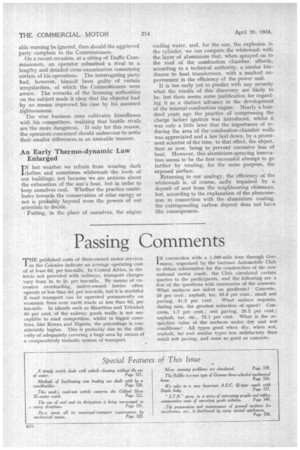Passing Comments
Page 32

Page 33

If you've noticed an error in this article please click here to report it so we can fix it.
T" published costs of State-owned motor services in the Colonies indicate an average operating cost of at least Eid. per ton-mile. In Central Africa, in districts not provided with railways, transport charges vary from is. to 2s. per ton-mile. By means of excessive overloading, native-owned lorries often operate at less than 6d, per ton-mile, but it is doubtful if road transport can be operated permanently on economic lines over earth roads at less than 6d. per ton-mile. In islands such as Mauritius and Trinidad 80 per cent, of the railway goods traffic is not susceptible to road competition, whilst in bigger countries, like Kenya and Nigeria, the percentage is considerably higher. This is probably due to the difficulty of adequately covering a huge area by means of a coinparatively inelastic system of transport. I N connection with a 1,500-mile tour through Ger
many. organized by the German Automobile Club to obtain information for the construction of the new national motor roads, the Club circulated certain queries to the participants, and the following are a few of the questions with summaries of the answers. What surfaces are safest on gradients? Concrete, 25 per cent.; asphalt, tar, 33.8 per cent.; small sett paving, 41.2 per cent. What surface requires, during rain, the greatest reduction of speed? Concrete, 1.7 per cent.; sett paving, 25.2 per cent.; asphalt, tar, etc., 73.1 per cent. What is the respective value of the surfaces under dry and wet conditions? • All types good when dry, when wet, asphalt, tar and similar types less satisfactory than small sett paving, and none so good as concrete.
AN amusing summary of the layman's requirements in road construction Was given by D. E. L. Burgin, Parliarnentary Secretary, to the Board of Trade, at a dinner of the .Paviors' Company. He remarked that the public required roads to be everlasting, capable of instantaneous repair, inexpensive, waterproof, but non-skid, pleasant to the eye and equally suitable for the huntsman, the racing motorist or the child who wished to spin a peg-top !
IX/AKERS of refuse-collecting vehicles have exer LVI creditable ingenuity in the cause of hygiene. Dust-excluding curtains, automatic covers, easily operated shutters, etc., make the machines themselves quite unobjectionable, but refuse bins are still carried, lidless, from house to street. Bins that remain closed except during the Moment of actual transference of their contents deserve wider use. The Converta and Ochsner systems are examples. Whilst aiming at complete prevention of the escape of dust, odour and germs, this loophole—this weak link in the chain of operations—remains, seemingly quite unnecessarily, just where it is particularly 17ndesirable.
THE condition in which roads, often unmade, are found after building operations in connection with the development of new housing areas are completed, sometimes leaves much to be desired. The Master Builders Federation has already had its attention drawn to this matter and it would be doing a service to the community in general if it impressed upon builders the need for greater care in this direction. Furthermore, stress should be laid upon the danger of dumping builders' material at the wayside, where it often constitutes a definite obstruction to traffic.
ALTHOUGH in his judicial capacity Mr. Gleeson E. Robinson, M.C., LL,D., the Metropolitan Traffic Commissioner, is firm, but just, in his Office he has a quiet, charming manner, and a smile that immediately puts one at one's ease. He combines the strict enforcement of the law with a recognition of human weakness, and when, on rare occasions, it is necessary for him to punish an operator, he is never harsh. His memory is one of the outstanding characteristics of a brilliant man, its retentiveness having in more than one case surprised—perhaps even embarrassed—an applicant.




























































































